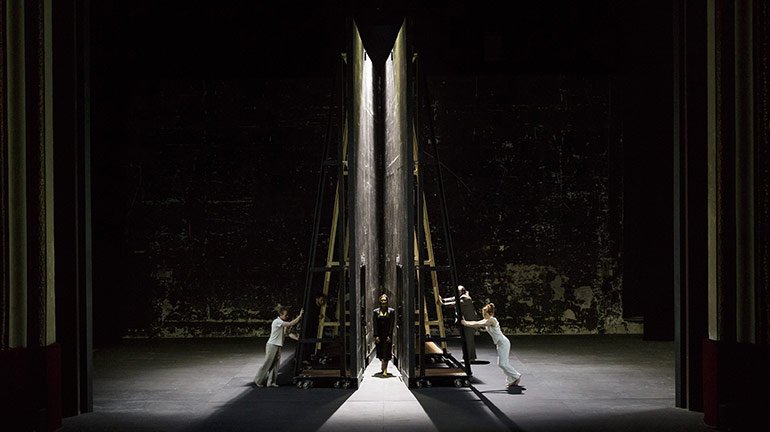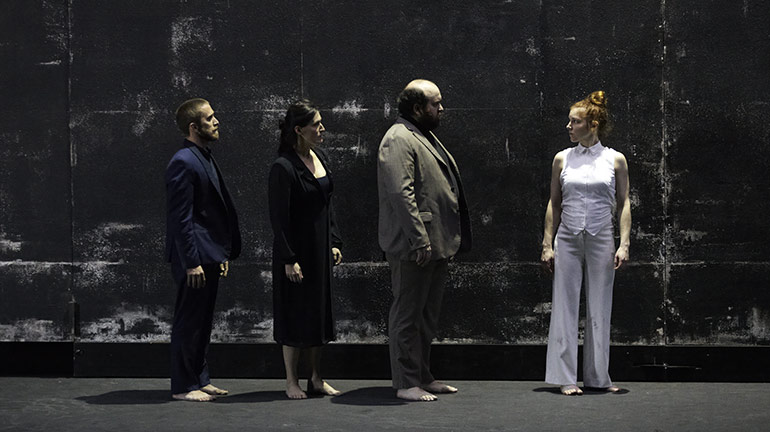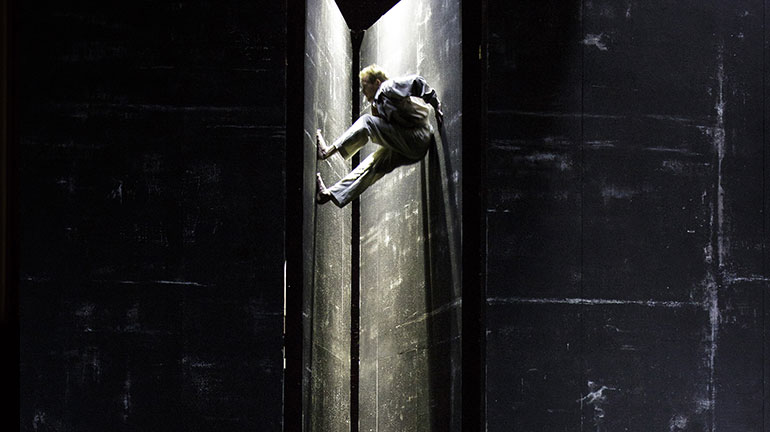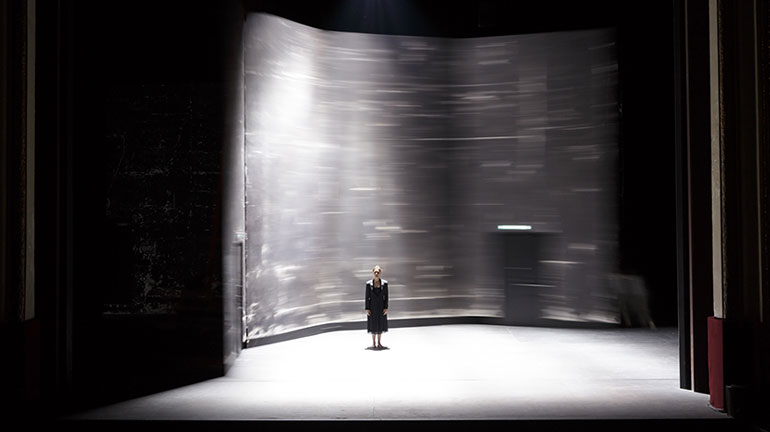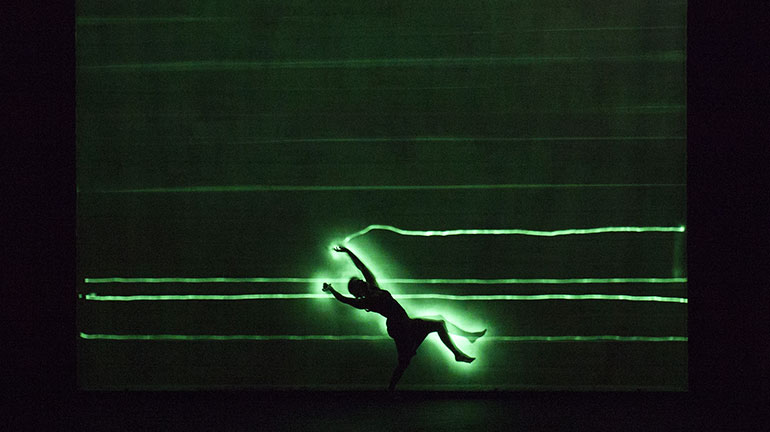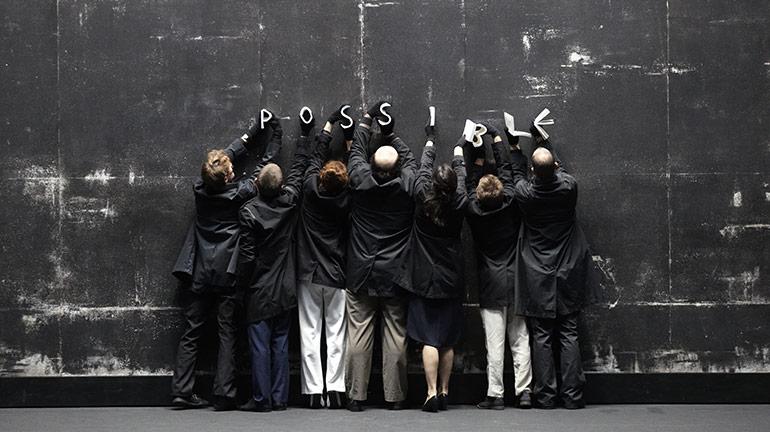de page
Espæce
A PIECE BY Aurélien Bory
created in 2016
I choose a word that doesn’t exist as the title. A word that has no meaning. That owes its form to two juxtaposed words, « espèce » (species) and « espace » (space), contained in the title of Georges Perec’s book Espèces d’espaces (Species of spaces), my starting point for this show. This juxtaposition is the one I explore in my approach to theatre : putting the species in the space, or even getting the species and the space to coincide.
In roaming through Perec’s book, in a way I am executing a programme. I start with the first sentence : “The purpose of this book is not the void exactly, but rather what is round about or inside it”. And I apply it to the void of the stage. I roam up and down the stage, physically, literally. I become part of its dimensions, I experience the physical laws that traverse it, I observe the machinery. I look round about. Round about is the only possible path that leads me to the inside. The void of the stage contains all forms, all shows. Round about is the place of traces. It is also the place of the particular trace that is writing.
The theatre carries the oft-repeated gesture of re-writing over the traces. The process of Espæce may resemble that : a juxtaposition, a palimpsest. Which would then join up with the last sentence in Georges Perec’s book: “To write : to meticulously try to hold on to something, to make something survive: to tear off some precise fragments from the vacuum that’s being dug, to leave, somewhere, a furrow, a trace, a mark or a few signs”.
Aurélien BORY, march 2016
« To live is to pass from one space to another while doing your very best not to bump yourself »
Georges Perec

Emptiness, A User’s Manual
29 June 2016
The hybrid artist Aurélien Bory draws inspiration from French author Georges Perec and his Espèces d’Espaces to give substance to his latest polymorphic creation. From the first letter of the novel to the first movement on the stage, we went for a report in Toulouse to understand how writing turns into space.
On the table lies a copy of Espèces d’Espaces by Georges Perec that Aurélien Bory constantly quotes during the interview. To the point where we wonder whether he hasn’t memorized the whole book, having lived with it for the past several months. Then he opens a notebook, a compilation of words and drawings: this is Espæce, his anticipated creation, contained on these pages—and likely in his head as well.
Working on the very matter of a written text is new to Aurélien Bory. “People have often held readings based on my work: Tanizaki’s Éloge de l’Ombre for Plexus, or even Kleist and Sur le Théâtre de marionnettes, one of my favourite bedside books. But this time, a book is specifically the starting point for the show: Espèces d’Espaces by Perec. I love the idea that, with Perec, the act of reading takes us to an inner world. He writes about it in Penser/Classer. There’s a sort of link between his writing and his own history—Perec the orphan who can’t find any trace of his mother. And Perec considers writing to be a sort of space, or surface.”
It’s not hard to imagine what attracted Aurélien Bory, a creator who’s been flouting the lines and boundaries of the stage since his debut in 2000 with his Compagnie 111.
On the peripheries of the new circus, dance and performance, he’s finally appearing at the Festival. “I don’t want to tell the story of Espèces d’Espaces, it’s better to read it. And the reader will make connections with their own story. I don’t want to use words to talk about it either. I’m thinking of the “prière d’insérer” in the book: it’s on a loose sheet of paper. This ‘gesture’ contains a way of being a part of the world,” states Aurélien Bory. “Beyond the text, what really interests me is precisely the Perec who’s not in the world, Perec the surveyor. He walked a lot. He tried to live in the alphabet. His writing is already a sort of geography. He had a project on twelve places in Paris that he would have described over twelve years. Unfortunately, he gave up that idea. He quoted Butor, who considered literature a puzzle. That’s what Perec was interested in: the missing piece. So, I realised that for him, writing was space”. This revelation comes through reading and then, gradually, takes the form of a performance with a variable geometry.
In fact, the Toulouse resident has been working on—living and breathing—this project for several years. “I’ve read almost all of Perec’s works to discover sticking points or punctuation marks.” And Aurélien Bory goes on to quote his Perec discoveries that inspired him: “So, the purpose of this book isn’t exactly emptiness, but what’s around it or inside it.” The director and scenographer wove together a series of events starting with this statement. “Perec mentions an inner world that can’t be filled. And I’m working on what’s around and inside the theatre.” This ‘emptiness’ is something new for Bory, who has always created stage objects full of surprises: a forest of cables for Plexus (2012), a living painting with Azimut (2013), a life-sized game and Chinese artists for Les Sept Planches de le ruse (2007).
“But this emptiness has to be attacked by the stage machine. Somehow like a nightmare, which would be even worse. At first I was thinking of a sort of pop-up device, you know, like the children’s books? But I dropped that idea when I realised I wanted to move towards the idea of a loss of bearings. Perec’s books were extremely precise, but they still had a sort of a rough draft feel to them.” The director used this ‘work in progress’ aspect as his working method. “I held three performances like three rough drafts. It was a long-term thinking process punctuated with openness to the public and spontaneous movements. We worked on it for a week and had no idea what would come of it. It was a game. Afterwards, I put the puzzle together, I took all these rough drafts and created this ‘discontinuous’ theatre.”
A team has formed around Aurélien Bory, multiplying the possibilities.
Five actors and two technicians who will attack the emptiness. Bory thinks the actor is already in the title. “Espæce is the human species. And in the theatre, we put the species in the space. There’s no emptiness all on its own. In a creation, you hope not to fall on your face, but you’re bound to mess up, trip up here and there. You just have to try to work it out the best you can”, he says, only half joking. He wanted to cover all the areas of living performances to take to the air and, to do so, called on an actor (Olivier Martin-Salvan), a dancer (Mathieu Desseigne discovered working with Alain Platel), a singer (Claire Lefilliâtre), a contortionist (Katell Le Brenn) and an acrobat (Guilhem Benoit). It’s the first time he’s worked with them all at once, though “I’ve worked with each them at some point”.
They meet in a room at the Théâtre national de Toulouse (except for the singer, who’s absent on that day) and literally play with the letters and the book. Each person throws out suggestions, but Aurélien has the final word, asking them to pick up the pace in such and such a section.
Martin-Salvan’s thunderous laugh punctuates the rehearsal. But in the hall, the atmosphere is much less relaxed with a trompe-l’œil décor, and accessories—the fly system becomes a smoke machine as the extras pass through.
Emptiness and fullness? Just a few days from the debut, everything seems to be falling into place, especially in Aurélien Bory’s overheated brain. Though the visitor might feel a bit lost in this world under (de)construction.
“Why did Perec write? To leave something behind. Whereas at the theatre there’s nothing left except for an inner wake, the memory we leave with the audience. At the theatre, we’re constantly rewriting, like a palimpsest. In a way, I’m moving away from what I usually do, creations with sophisticated staging. I wanted Georges Perec to take me away. There will be evidence of my previous shows. Perec said: ‘I don’t want to write the same book twice’”.
As the weeks of rehearsals pass, it becomes clear that the inner space has much to do with memory. But Bory sees something more: “I love it when Perec quotes an ‘unknown author, and he does it often, who said: ‘The theatre follows very specific rules that no one has ever established.’ I spend as much time cheating as I do following the rules. That’s his relationship with truth and it doesn’t bother him.”
Aurélien Bory isn’t done with Perec, yet. And he’s glad of it: “I couldn’t have ignored a writer as obsessed by space as Perec is.” And he mentions that this member of the Oulipi movement worked on palindromes, that figure of speech that reads the same backward and forward. “X was his favourite letter,” he notes. We forgot to ask the director what his was. We might start with A as in Avignon.
Philippe Noisette
CASTING
With Guilhem Benoit, Cochise Le Berre, Katell Le Brenn or Lise Pauton, Claire Lefilliâtre, Olivier Martin-Salvan
Original creating roles Guilhem Benoit, Mathieu Desseigne Ravel, Katell Le Brenn, Claire Lefilliâtre, Olivier Martin-Salvan
Design, scenography and direction Aurélien Bory
Artistic collaboration Taïcyr Fadel
Lighting design Arno Veyrat
Musical composition Joan Cambon
Technical scenery design Pierre Dequivre
Costumes Sylvie Marcucci, Manuela Agnesini
Automatism Coline Féral
Technical Director Arno Veyrat
Stage Manager Thomas Dupeyron or Thomas Tallon, Mickaël Godbille
Sound Manager Stéphane Ley
Lighting Manager Mallory Duhamel or Arno Veyrat
Head of Production Florence Meurisse
Production Manager Clément Séguier-Faucher
Press Plan Bey Agency
Song Winterreise (Winter Journey) by Franz Schubert
Quotes Georges Perec, Espèces d’espaces, © Éditions Galilée, 1974
PRODUCTION Compagnie 111 – Aurélien Bory
COPRODUCTION Festival d’Avignon, ThéâtredelaCité – CDN Toulouse Occitanie, Le Grand T théâtre de Loire-Atlantique – Nantes, Le théâtre de l’Archipel scène nationale de Perpignan, Théâtre de la Ville – Paris, Maison des Arts de Créteil, Le Parvis scène nationale de Tarbes Pyrénées
Rehearsals and residencies La nouvelle Digue – Toulouse, La FabricA-Avignon, ThéâtredelaCité – CDN Toulouse Occitanie, CIRCa – Auch
Compagnie 111 – Aurélien Bory is under funding agreement with the Regional Directorate for Cultural Affairs Occitanie / French Ministry of Culture and Communication, Region Occitanie / Pyrénées – Méditerranée and the City council of Toulouse. It is supported by the Departmental Council of the Haute-Garonne.
Photos : Aglaé Bory, Christophe Raynaud de Lage.



